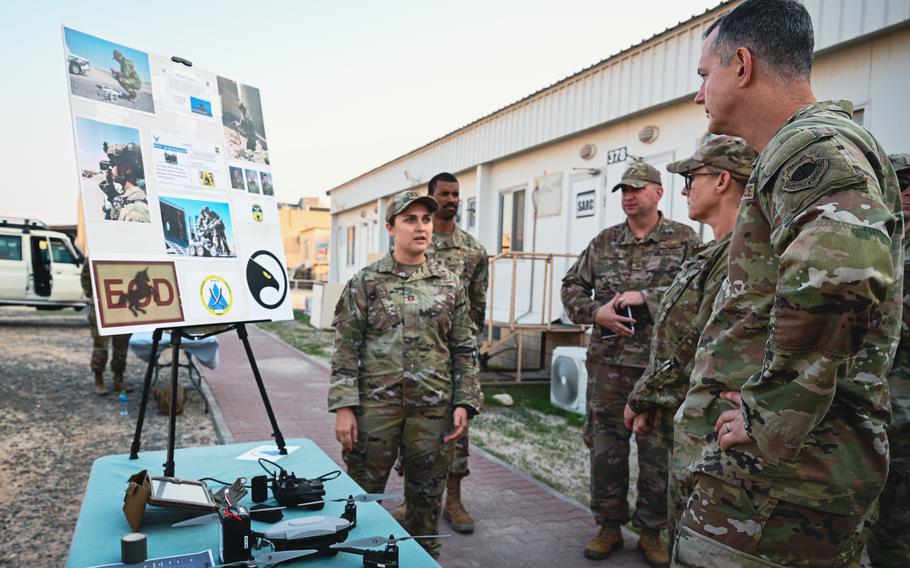
Air Force Lt. Gen. Alexus Grynkewich, commander of the Ninth Air Force (Air Forces Central), learns about one of the projects of Task Force 99 on Dec. 11, 2022, from Capt. Ana Smith of the 386th Expeditionary Civil Engineer Squadron, Explosive Ordnance Disposal, at Ali Al Salem Air Base, Kuwait. (Micah Coate/U.S. Air Force)
WASHINGTON — The top Air Force commander in the Middle East said Monday that the service will have to lean more on innovation to secure the region now that U.S. forces are out of Afghanistan and the Pentagon is focused on Russia and China.
Lt. Gen. Alexus Grynkewich, the commander of Air Forces Central, or AFCENT, said the Ninth Air Force is having to make do now with fewer resources in the region with more pressing threats in Eastern Europe and the Indo-Pacific region.
“We want to make sure we are keeping enough pressure on violent extremist organizations so they can’t carry out an attack on our homeland,” Grynkewich said during an interview with the Center for a New American Security, a Washington-based think tank funded by several defense contractors including Northrop Grumman. “That would have the potential to derail our focus on China.”
The Pentagon’s National Defense Strategy and President Joe Biden’s National Security Strategy were issued in the fall and identified China as the top U.S. competitor and “pacing challenge” — with Russia and North Korea not far behind. The strategies still place importance in the Middle East, but the region now garners less attention after the withdrawal of American troops from Afghanistan in 2021.
“Iran is the other one we have to keep an eye on,” Grynkewich said.
He said all U.S. commands are having to adjust their strategies, and for the Air Force in the Middle East that means relying more on brain power than traditional firepower.
“Where we are trying to shift our focus is thinking about how we reshape the region over the longer term,” Grynkewich said. “That means a lot of partnering … that means a lot of collaboration, that means a lot of longer-term thinking about what is it that we’re doing on a daily basis.”
Several months ago, the Air Force established Task Force 99, a unit dedicated to developing a “culture of innovation” to do more with less. Known as the Desert Catalysts, the unit is based in Qatar and since its formation, TF99 has tested drones, rockets and other technology experiments that it hopes will streamline capabilities.
Putting new emphasis on experimenting and inventing is a direction other military branches are also exploring. A few weeks after TF99 was created, the Army established its version of the unit — Task Force 39, which has also been charged with creating innovations that give the Pentagon more bang for its buck.
“Getting these new capabilities tested in [the Middle East] is what we bring to the table,” Col. Adontis Atkins, commander of Task Force 39, said recently. “Actually getting it in the hands of soldiers and getting that feedback.”
For example, Atkins said the Army will soon be testing semiautonomous cargo trucks on Middle East terrain. In 2021, the Navy formed a similar tech unit, Task Force 59, and the Air Force wants to copy its success.
“[Task Force 99] is a shameless attempt to replicate the success of Task Force 59,” Grynkewich said. “It is a command that I have given some very hard tactical problems to … that they are empowered to go out and find solutions for.”
Even in the Middle East, U.S. forces are seeing influence from China and Russia, the AFCENT commander said. Moscow has been a supporter of the government in Syria for many years and Grynkewich said Beijing wields serious economic influence across the region.
Already strained U.S.-China relations have been tested further in the last two weeks in the wake of the Chinese spy balloon incident, which was shot down over the Atlantic Ocean on Feb. 4 after it traveled across the United States. U.S. fighter jets also shot down three different objects in the skies over North America last Friday, Saturday and Sunday. The origins of the objects shot down over the weekend have not been identified yet, U.S. officials have said.
Grynkewich said Monday that he knows of other high-altitude objects that crossed over the Middle East in the recent past. He declined, however, to identify them as balloons and didn’t say from where they might have emanated.
“Even though we have seen high-altitude [objects] in the region before, they have not been a threat,” he said. “The level of concern that I have about them is extremely low. … It’s not something that I would lose sleep [over] at night.”